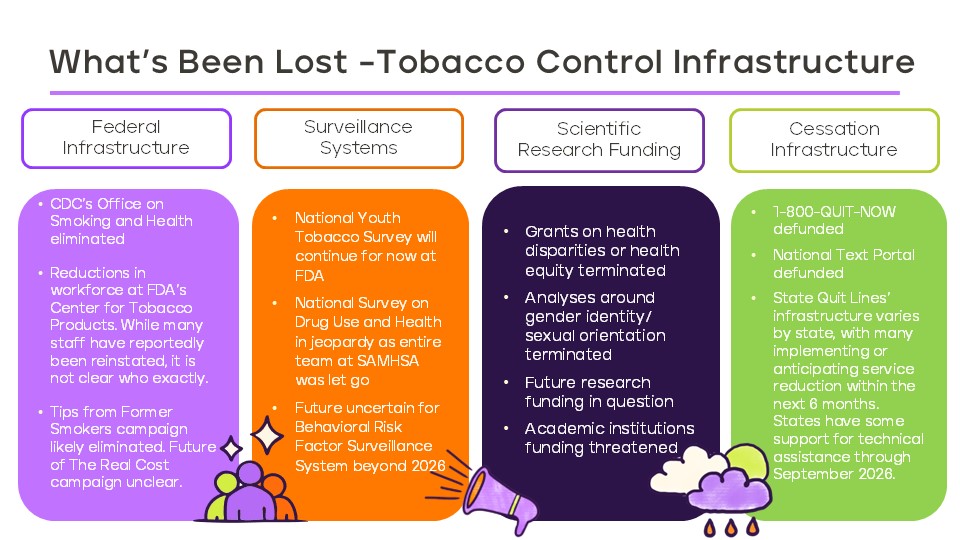What federal health agency cuts mean for tobacco control
Last Updated: December 10, 2025
On April 1, the U.S. Department of Health and Human Services (HHS) announced sweeping cuts that have profound impacts on federal tobacco control efforts. Many foundational systems supporting tobacco use prevention, cessation, research, and public education have been substantially reduced or eliminated entirely.
These cuts include eliminating the Office on Smoking and Health at the Centers for Disease Control and Prevention and significantly scaling back the Center for Tobacco Products at the Food and Drug Administration, agencies that regulate tobacco products and monitor and attempt to reduce tobacco use. While many staff have reportedly been reinstated at FDA CTP (though it is still unclear who exactly), CDC OSH remains eliminated.
On May 5, twenty state attorneys general filed a lawsuit against the cuts at the U.S. Department of Health and Human Services, challenging the Trump administration's unconstitutional dismantling of the department and urging the court to restore these critical public health programs. On July 1, the District Court in Rhode Island granted the request for a preliminary injunction, temporarily blocking the mass layoffs at HHS. The plaintiffs filed an amended complaint on September 5. On September 17, the U.S. Court of Appeals for the First Circuit denied HHS’s request for a stay of the injunction granted by the District Court. On October 30, HHS voluntarily dismissed its appeal of the District Court’s preliminary injunction. This means HHS cannot implement its reduction-in-force (RIF) and restructuring plans for the four sub-agencies covered by the lawsuit, including staff at CDC OSH and FDA CTP. Those affected will remain on paid administrative leave until further notice. The case is ongoing.
CDC Office on Smoking and Health
The CDC Office on Smoking and Health plays a critical role in preventing youth tobacco use and helping adult tobacco users to quit.
Layoffs, extended administrative leave, and the potential elimination of CDC OSH puts the following programs at risk:
Public education:
- The Tips from Former Smokers® public education campaign encourages people who smoke to quit by featuring real people living with serious long-term health effects from smoking and secondhand smoke exposure. They share the impact smoking has had on their lives—and the lives of their loved ones. During 2012-2018, The Tips campaign helped over one million people successfully quit and helped save an estimated $7.3 billion in smoking-related healthcare costs.
State tobacco control funding and assistance:
- CDC OSH is the only federal agency that provides funding and technical assistance to state and territorial health departments for tobacco control efforts. While state and territorial tobacco control programs received funding in October for the FY25 National and State Tobacco Control Program grant that must be spent down by April 30, 2026, future funding through the grant remains in jeopardy without CDC OSH.
- For every $1 spent on comprehensive tobacco control programs, states get a $55 return on investment, mostly in averted health care costs to treat smoking-related illness.
- Without funding from CDC OSH, states would lose approximately $69 million in funding for their tobacco control programs. Currently, states receive funding from OSH each year, ranging from $343,000 to $2.3 million, based on population size, rates of tobacco use, and other state-specific factors.
- Without funding from CDC OSH, states would lose approximately $16 million in funding for their state quitlines. Quitlines in 23 states and 2 territories rely on CDC for at least a quarter of their funding; 5 of these states and the 2 territories rely on CDC for at least 75% of their funding.
- Loss of federal funding from CDC OSH has already led to:
- the closure of Raze, a youth-led tobacco prevention program in West Virginia;
- New York state’s tobacco control bureau losing 13 staff members, slowing down the local programs that relied on those staff for support;
- Georgia’s tobacco use prevention program shutting down in May 2025;
- North Carolina’s tobacco prevention and control program losing 9 staff members and all anti-tobacco initiatives that serve adults except the state quitline; and
- some state quitlines drastically reducing their services such as scaling back phone counseling services to a single call and stop offering free cessation medications.
Data collection and evaluation:
- CDC OSH funds data collection, evaluation, research, and lab activities that monitor tobacco use and its health effects. CDC OSH and FDA conduct the National Youth Tobacco Survey, which collects data on tobacco use by high school and middle school students, including which products they are using, how often they use them, and how youth access them.
FDA Center for Tobacco Products
The FDA Center for Tobacco Products regulates the manufacturing, marketing, and distribution of tobacco products and educates the public about the dangers of using tobacco products. FDA CTP is completely funded by tobacco user fees collected from domestic manufacturers and importers of cigarettes, snuff, chewing tobacco, roll-your-own tobacco, cigar, and pipe tobacco. Thus, there is no savings to American taxpayers with these layoffs. Here is what we know about the reductions in workforce at the center:
Leadership and staff:
- CTP Director Brian King was placed on administrative leave.
- The leadership of the Office of Science, responsible for the review of tobacco products, was removed. Matthew Farrelly was reinstated as Director of the Office of Science in October.
- The office responsible for conducting public education, stakeholder outreach, and regulatory communication programs had layoffs to its leadership and staff working on public education campaigns. This is devastating for FDA’s The Real Cost campaign, which works to prevent youth from starting use and explains the risks of tobacco products. The Real Cost prevented an estimated 444,252 youth from starting to use e-cigarettes between 2023-2024. Without this prevention public-education campaign, we will see rates of youth tobacco use increase. As of August, reportedly much of the staff working on public education campaigns were reinstated, though the future of The Real Cost campaign remains unclear.
- Staff responsible for issuing warnings letters and penalties to retailers selling tobacco products to underage people were laid off and have since been asked to temporarily return
- The regulations division, which issues regulations regarding tobacco products and guidance documents for the tobacco industry, was cut essentially entirely.
- The management division was cut entirely, which is responsible for overseeing the center’s administrative services and operations.
- According to a motion for preliminary injunction, FDA CTP has paused compliance checks to ensure tobacco products are not sold to minors and has paused review of premarket applications of tobacco products.
While many of the staff laid off at FDA CTP and mentioned above were reinstated months later, it is unclear who. FDA has not been transparent or stated publicly when staff have been reinstated. Less staff at FDA CTP to enforce current regulations will likely result in more tobacco products coming on the market and almost no new regulations issued to further its mission of reducing tobacco-related death and disease.
Want support quitting? Join EX Program
By clicking JOIN, you agree to the Terms, Text Message Terms and Privacy Policy.
Msg&Data rates may apply; msgs are automated.

